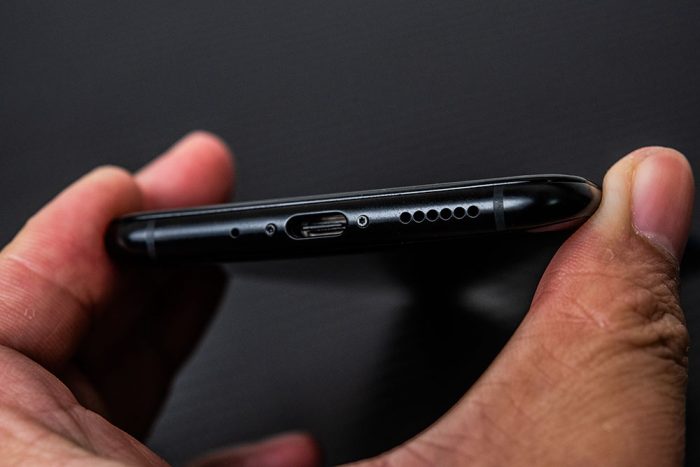On March 1, vivo launched its new smartphone- the vivo iQOO. This 6.41-inch full-screen phone has caught the attention of the public since its release. Both iQOO and the Xiaomi Mi 9 are powered by Snapdragon 855 processor, but the former is cheaper. Today, we will check its internal structure and workmanship.

It features a glass back cover. There is a screw on the two sides of the USB port.
First of all, remove the SIM card tray.
Taking out all the screws before separating the back case from the phone body. The disassembly process is slightly difficult.
Now, the back cover is removed. There is a cable which connects the phone body to the back shell.
From the picture, we can see several cables on the back cover.
A cable connects the back cover to the phone body. In case the cable gets loose, there is a metal strip on the cable port of the motherboard.
Remove the metal strips, and disconnect the cables.
Now the back cover is completely taken out. The back case is covered by a graphite sticker.
The LED flash is connected to the motherboard via a cable.
We can see two LEDs at the cable end.
The iQOO has a good antenna design.
It also adopts a classic three-stage design. The motherboard is on the top, the battery in the middle and the small board is at the bottom. Most popular phones have used the design except iPhone.
The small board is covered by a shield.
Remove the shield, and the PCB can be seen.
We can find a speaker and a motor on the shield.
The small board is used to connect USB port, antenna, and peripheral devices.
One cable on the battery connects to the small board, and the other connects to the motherboard.
The iQOO sports a 4000mAh battery which supports 44W fast charge.
It’s easy to remove the battery.
This is the battery we get.
We can see the heat pipe on the middle frame.
The pipe is bigger, which can make the phone have a better heat dissipation performance.
Besides, the copper foil covers the motherboard, which can improve heat dissipation performance.
The phone comes with three cameras on the rear, including a wide-angle camera, the main camera, and an in-depth camera.
The copper is connected to the heat pipe. This design is good for heat dissipation.
It’s the front of the motherboard.
It’s the back of the motherboard.
After removing the shield, we can see the conductive silicone. The iQOO has a good heat dissipation design.
This is the motherboard without the shield removed.
The phone is powered by Qualcomm Snapdragon 855 processor. It adopts a two-layer packaging process. The CPU is on the top and the memory chip is at the bottom.
The phone comes with a 128GB ROM.
It also features a 12MP front camera.
Besides, it comes with a 12MP main camera, a 13MP wide-angle camera and a 2MP camera.
Summary
We find that the vivo iQOO uses good materials. The heat pipe is good for the CPU’s heat dissipation. The phone also has a reasonable internal structure. On the whole, the iQOO is an affordable smartphone.